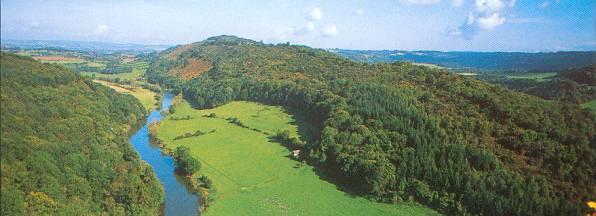
The Local Time is Saturday, 27-Apr-2024 02:28:27 CEST
History
of the Royal Forest |
|
||||
| YOU ARE HERE: Main Home Page > Places to Visit > History of the Royal Forest of Dean |
|
|
|
|
|
|
 |
|
 |
|||||||||||||||||||||
Some more History of the Royal Forest of DeanThe Royal Forest of Dean was designated as a national forest park in 1938, the unique heritage and culture of the Forest reflects a close working relationship between people and the environment. The underlying rocks of the Coal Measures, Carboniferous Limestone and Old Red Sandstone together with the rich veins of haematite ore gave rise to the mining and quarrying industries. The existence of coal and iron ore, together with charcoal from the Forest for smelting, stimulated early industrial development in the area. Since Roman times this mineral wealth has been explored, exploited and exported’. The digging for iron has left distinctive galleries or 'scowles’ in the rock face; the coal mining has produced tips of waste and furnaces and forges line river courses. Today, these symbols of the Forest industrial past have been softened by time and today are integrated into the landscape. These scowles can be seen by visiting Puzzle Wood and Cinderbury. Coal mining, until 1955 was one of the area’s main industries with five collieries (the last closed in 1965), and is still undertaken at a few small mines operated by Freeminers. The centuries old mining rights (applied to iron ore, coal and other minerals and even quarrying for stone) entitle any male born within the hundred of St Briavels, aged 21 or more and who has worked for a year and a day in a mine to legally register as a Freeminer with the chance of being granted a 'gale’ of coal (or ore). Hopewell Colliery and Clearwell Caves offer underground tours and are ideal bases from which to learn more about the Forest’s Freeminers The 19th century saw the major development of industry. Enterprise and innovation combined with rich natural resources brought inventions, investors and workers to the Forest from many parts of Britain. Industrialisation demanded improved communications and better transport links. In the late 19th century original tram roads were converted to railways with all the Forest towns connected to the main lines bordering the area and linking with the docks at Lydney. Lydney Harbour has recently been restored to preserve its historical importance as a key player in the industrial development of the Forest of Dean. As a woodland, the Forest of Dean has played an important part in the heritage of Britain especially from the 17th century when the oak timber, and indeed iron, became important for the expanding shipbuilding industry. The exploitation of the area’s timber and iron ore resources continued throughout the Civil War but in 1649 recommendations were made for the conservation and management of the Forest. This was pursued by a Commission whose long-term work was scuppered by growing demand from the Navy. It was not until the Dean Forest (Reforestation) Act 1668 that effective management commenced, albeit dogged with trouble for another 120 years. During a visit to the Forest in 1802, Lord Nelson highlighted that the 'finest timber in the kingdom’ was in a deplorable state. Consequently 30 million acorns were planted across 11,000 acres, but the oak was redundant before half grown thanks to its rapid replacement in shipbuilding by iron and steel! Despite further demands during the war years, the Forest, due to careful planting and felling programme's, has maintained much of its traditional appearance. In addition, much of the war-time felling was replanted with oak and other broad leaved mixtures. The National Forest policy of 1958 emphasised the need for timber production but highlighted the need for due regard to amenity and recreation. Visit the Dean Heritage Centre to discover more about the Forest’s fascinating history and heritage. |
|||||||||||||||||||||
|
|||||||||||||||||||||
|
|||||||||||||||||||||
Places to visit in The Royal Forest of Dean, Wye Valley, Severn Vale and the Vale of Leadon |
|||||||||||||||||||||
| This page last modified Tuesday, 28-May-2019 10:59:40 CEST | |||||||||||||||||||||